Overhead Cranes for Steel Metal Structured Crane Building
An overhead crane has many applications in various industrial sectors. They can handle large and bulky loads, help with product assembly and manufacturing, load trucks and containers efficiently, and maximize floor storage space in your facilities such as, workshop, warehouse, workstation,etc.
Not all steel structured buildings are capable of sustaining such high loads overhead, and such a requirement must be incorporated into the building's design from the start. Failure to do so may reduce the building's future capability and usability as business requirements change.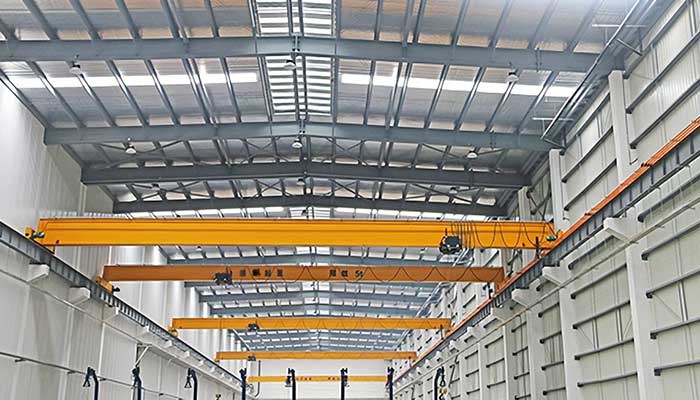
Overhead crane designed for steel structured workshop
Benefits of overhead crane installing in steel structured factory
There are, however, numerous advantages to having an overhead crane in your facility . Among these are, but are not limited to, the following:
- Utilization of underutilized building space.
- From a secure distance, the material handling crane can be operated.
- Moving bulky and uneven heavy cargo safely.
- Reduce the use of floor dangers like telehandlers and forklifts.
- Load control has been improved, and very large loads can now be moved.
While some material handling operation needs in the manufacturing and storage are better adapted to using forklifts to move and lift products and assemblies, many business have resorted to using them as a cost-effective way to start a production or assembly facility. However, as a process expands, using forklifts in industrial processes can introduce new risks and costs that can be avoided.
A forklift takes up a lot of room and also can easily damages products or machinery in the process accidentally. When compared to an overhead crane, which travels above high over the, machinery, and personnel, it is easy to see how an overhead crane enables you to maximize your floor space.
Risks of forklift operation
When using a forklift, the operator must ensure that the load is carefully and properly stacked, or the load or object may topple, resulting in serious repercussions. Forklifts operate on the ground level, posing a risk to those working on the factory floor, and a forklift, or telehandler, needs a certain amount of space to move around the shop and then swing the load into position.
the safest possible working environment needs to be created and provided by the business owners and directors. Whereas busy reasons and greater demand increase the risks at work.The moving goods and loads and people working at high speeds increases the chance of an accident. Safety measures like walkway barriers and gates will help to increase safety, but with forklift operator error being a main cause of accidents, there's only so much a company can do. The best course of action may be to eliminate potentially hazardous operation and activities as much as possible.
Overhead crane considerations
Overhead cranes have numerous safety advantages over trucks and telehandlers. In addition to reducing floor-level hazards, the operator isn't multitasking as much as a forklift driver, allowing them to watch hazards and risks.
Overhead crane safety training is available for crane users and operator to further reduce risk. At Yuantai Crane we could provide free crane operation training conduction for clients including free operation manual, video consultation, and other possible means. Here is to way, overhead crane is an affordable safety choice. Equipped with modern features in your overhead crane, such as anti-sway technology, which allows an operator to move and position loads more precisely using the load's center of gravity, increasing safety even further.
Bringing in expert guidance on overhead crane installation from the start of a new building's construction is one of the most significant ways an overhead crane can be made safe and increase productivity. While gantries place a significant load on the structure, it is not necessary exponentially more expensive to design the structure to support a gantry now or in the future.
At Yuantai Crane, we have a wealth of experience at designing overhead cranes into buildings with engineering skills to ensure it fulfills user requirements.
Overhead cranes can be configured to client specifications:
- Drives with variable speeds for precise control.
- Two hoists are included for long length load handling.
- Two or more overhead cranes can operate together to handle extremely long loads or share extremely heavy loads.
- Overhead cranes can typically be provided with much greater lifting capacities than a forklift.
- Various security measures (Flashing lights, sirens, limits, overload limits, etc).
Types of travelling cranes for you
There are several types of overhead cranes that can be installed in an Structural Steel building, with the primary two being highlighted below:
Traveling overhead crane with a single girder design
As one type of the most frequently used overhead crane, the single girder overhead crane is welcomed by its simple structure and power full handling capacity from 1 ton to 20 ton, economical price. The single girder overhead crane has a single beam span between the two rail centers. The lifting hoist is suspended on the lower part of crane bridge which is supposed to carry the loads to move horizontally along the main beam and hoist the loads vertically.
Double girder travelling overhead crane
The double girder configuration provides greater lifting capability. The crab hoist trolley will travel on the top of the two bridging girders, providing higher load-bearing capability while maintaining the same maneuverability as a single girder setup.
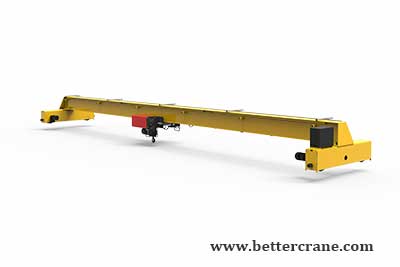 Single girder overhead crane Crane capacity: Top running design up to 32 ton, underhung design 0.25 -20 ton.
Single girder overhead crane Crane capacity: Top running design up to 32 ton, underhung design 0.25 -20 ton.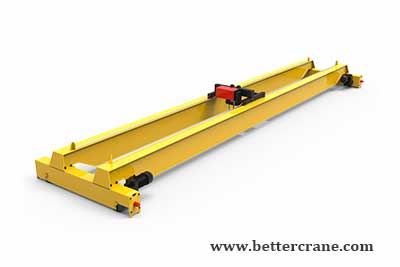 Double girder trolley / winch overhead crane Crane capacity: 5 ton -550 ton
Double girder trolley / winch overhead crane Crane capacity: 5 ton -550 ton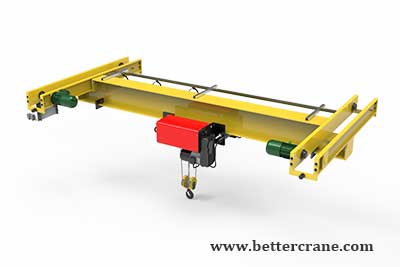 European standard fem underhung overhead crane 500 kg -10 ton
European standard fem underhung overhead crane 500 kg -10 ton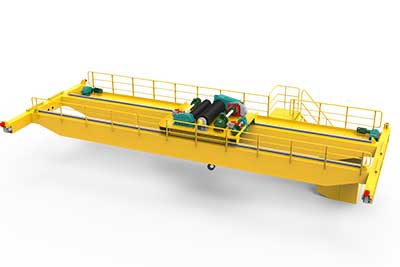 Hoist, winch & trolley overhead crane for sale Crane Lifting system : Electric hoist 0.25 - 80 ton, winch trolley hoist up to 550 ton
Hoist, winch & trolley overhead crane for sale Crane Lifting system : Electric hoist 0.25 - 80 ton, winch trolley hoist up to 550 tonOverhead cranes have a theoretical design life of 25 years in most instances, while component has a theoretical design life of 10 years - after the first 10 years, the crane can be overhauled and used for another 10 years. Because of the extreme loads that overhead cranes are subjected to, it is always recommended that frequent inspections be performed.
There are conditions when more than one overhead crane is installed and operated in a bay. When two or more electric cranes work in the same bay, anti-collision devices can be installed between the bridge cranes to improve safety and reduce errors. If an engineer specifies that the bridge cranes be spread apart for building loading, this device can be configured to meet that specification. (i.e. 6m gap between the two overhead cranes for instance). Even if there is no spacing rule, the device slows the cranes as they approach one another and prevents high-speed impact.
If you're creating a commercial building as an investment that will be leased to another company, a complete overhead crane installation may not be necessary, but the groundwork and structural engineering to support an overhead crane in the future can be considered. Buildings with only corbels installed to "future proof" the building (excluding the Downshop runway beams, crane rail, and end stops) are possible if maximum versatility is desired - this makes adding a crane and supporting steelwork in the future much simpler and less expensive.
If you're contemplating a new commercial building for your company and want to learn more about the advantages and considerations of an overhead crane, please feel free to contact us. Check what we can to do for your steel crane building and overhead crane design. Leave a message now.




